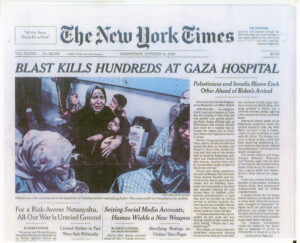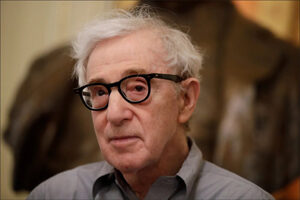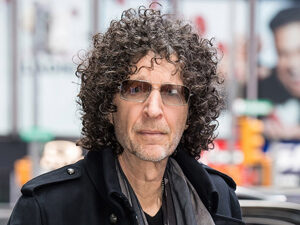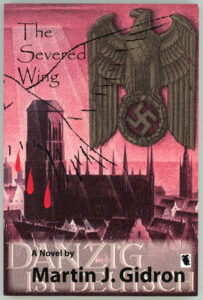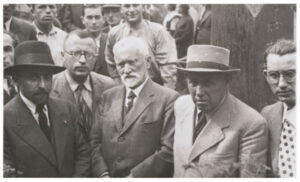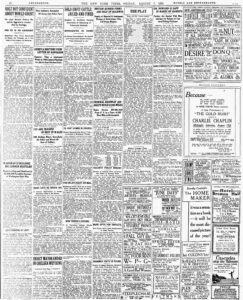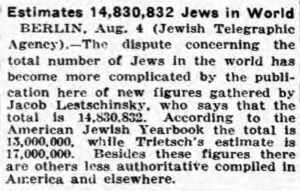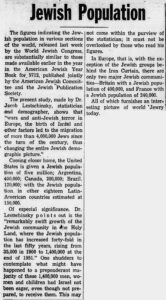“…the Times is not, in fact, a newspaper, but a status symbol.” – Benjamin Kerstein
____________________
Same as it ever was, same as it ever was
(Same as it ever was, same as it ever was)
Same as it ever was, same as it ever was
(Same as it ever was, same as it ever was)
Same as it ever was, same as it ever was
(Same as it ever was, same as it ever was)
Same as it ever was, same as it ever was
(Same as it ever was, same as it ever was)
____________________
The year 2023 has ended, and the year 2024, arrived.
Who knows what it portends? Perhaps best not to know.
The future will arrive of its own accord, regardless of the hopes and fears; the wishes and dreams; the wonders and imaginings, of men.
Thus far, here at TheyWereSoldiers, I’ve completed nearly 300 posts – more to come, I hope! – many of which pertain to the military service of Jews during the Second World War. For posts covering this topic, a significant source of information has been The New York Times, which – like virtually all other American newspapers during the war – routinely published War Department Casualty Lists, and, news items about specific soldiers. In terms of information specifically about soldiers in the American armed forces, without the Times this blog would be neither timely nor topical. But (!) a major qualifier: The centrality of The New York Times to my blog is neither advocacy of nor an endorsement for that newspaper in terms of its editorial policy – it certainly has one! – concerning the Jews, Juda-ism as a religion, Jewish nationalism, Jewish self-defense, or Zionism.
And especially, the re-established nation state known as Israel.
Quite the contrary.
As shown in the works of David S. Wyman (The Abandonment of the Jews), Laurel Leff (Buried by The Times), Jerold S. Auerbach (Print to Fit: “The New York Times, Zionism and Israel, 1896–2016“) and other scholars, the ideology of the Times for over a century has neither accepted nor admitted that the rights tacitly accepted – if not celebrated! – for other peoples and nations should be accorded to the Jews. Even now, in the early twenty-first century, the Times remains by default – nay calculatedly; nay, eagerly! – mired in a mindset that is unable reconcile itself to the Jews as a thriving, autonomous nation, in preference to existing in a scattered, subservient, conditionally accepted, passive condition.
That this attitude continues today was stunningly evident in the newspaper’s lead article of October 18, 2023, published eleven days after Hamas’ mass murder of well over one thousand Israeli Jews. Titled “Blast Kills Hundreds at Gaza Hospital“, the above-the-fold “article” (I use the term generously) was written by Patrick Kingsley, Aaron Boxerman, and Hiba Yazbek, and accompanied by a large-format photo taken by Associated Press photographer Abed Khaled. (An observation: From the standpoint of pictorial composition and emotional power, is it a coincidence that the image – so powerful, one must admit! – imparts a “Madonna and Child“-like symbolism to the civilians of Gaza, and thus villainy to Jewish soldiers; to Israel; to the Jews?)
Here it is:
For the full, actual story surrounding the origin of this manufactured “event”, the veracity of which was so immediately accepted and then boldly propagated by the Times, go to Tablet, and check out…
Anatomy of a Blood Libel – With the initial claims of the hospital story debunked, all that is left is the eternal guilt and villainy of the Jewish people, by Clayton Fox (October 30, 2023)
…and…
Pallywood’s Latest Blockbuster – How the media’s lockstep coverage of the Al-Ahli Hospital explosion promoted Hamas propaganda, by Richard Landes (November 29, 2023).
Given the Times’ willingness to distort news about Israel (and hardly just Israel…) if not flat-out lie in accordance with its predetermined beliefs concerning the Jewish people, the question remains as to why in this year of 2024 its prominence and centrality in the world of information, news, and social influence seems undiminished. The explanations for this are several. Perhaps it’s the transition in the nature of the news media – in light of the advent of the Internet – from the advertising model, to the subscription model, whereby rather than objectively convey information, a periodical’s raison d’être is to reflect, validate, and promote the beliefs and assumptions of its readers. Perhaps it’s the rise of massive, multifaceted media and information conglomerates and the simultaneous loss of regional and local newspapers. Perhaps it’s explained by the Times – and not just the Times – relying on news (or more properly “news“) generated by, from, and for the pixelated oxymoron otherwise known as social media. And, segueing from that (!), perhaps it’s the metamorphosis of journalism from a vocation which once the cultural overtones of a blue-collar literary “trade”, to a credentialed profession reflecting the “moral inversion” of belief and values (to use Michael Polanyi’s phrase, adapted by the late Sir Roger Scruton) that has occurred throughout the atrophying “West” at least since the 1960s. (In truth, this metamorphosis began far, far earlier than the 60s, and I think has arisen from values and beliefs inherent to West itself. But, that is the subject of another discussion…)
But, there’s a factor explaining the paper’s continuing centrality in Western culture that is unrelated to the interpretation and presentation of “information”. That is, class … as in social class. Or more precisely, a function of the Times is to establish and validate the social status of its readers – the credentialed, meritocratic, technocratic (and largely secular) “elite” – y’know, the “professional managerial class” – in the eyes of their peers. And most importantly, themselves.
This is very clearly explained by Benjamin Kerstein (No Delusions, No Despair) in his Substack post of November 3, The war from over here, part3: “…the remarkable halo effect the paper enjoys persists and has, if anything, grown stronger. By rights, the Times should have been forced by scandal and cancelled subscriptions to close up shop years ago. But it has remained popular, universally read among the American aristocracy, and decisively influential over the entire media landscape in the US. It is, in effect, the world’s most prestigious and omnipotent gutter rag.
My friend had a fairly decent explanation for this, which is that the Times is not, in fact, a newspaper, but a status symbol. It signals one’s membership in or aspiration to join the American aristocracy, and thus carries with it a whole host of connotations that make it irresistible to the members of that class and its admirers.
Those connotations include an elite education, high intelligence, considerable or at least comfortable wealth, and a general disdain for one’s class inferiors. It also signals adherence to a series of ideals like compassion, equality, tolerance, and general love for mankind.
Thus, it displays one’s membership in a caste of saints who are not only materially successful, but consider themselves the finest and most moral people who have ever existed in the entire history of the universe. One can then feel comfortable sitting in judgment of anyone who doesn’t belong to that caste and even enjoy doing so.
All of this would be fine, and frankly amusing, if weren’t for the fact that people are getting hurt. The Times’ prestige isn’t just risible, it causes real world violence. The paper was forced to admit that it lied about the Gaza hospital explosion, but it doesn’t matter. Large sections of its readership will continue to believe it, and blame the Times’ capitulation on a Jewish conspiracy. They will do so because the Times told them to.”
So, it’s with these thoughts in mind that I reflect on an article about the Times by William Cohen (about whom I have no further information!) which appeared in the Jewish Frontier over eight decades ago: in February of 1942. At first briefly complimentary in its description of the paper, Cohen’s wide-ranging yet forceful essay then shifts to focus on the newspaper’s coverage of news about Jews in terms of American society and politics; the creation of an autonomous Jewish military force alongside the Allies to combat the Axis; Jewish nationalism; Zionism.
Given his words, it’s apparent that the true nature of the Times has been evident for many decades, to those who deign to look.
Or, in the words of Charles Peguy, “We must always tell what we see. Above all, and this is more difficult, we must always see what we see.”
As you can see, below.
____________________
But first…! Here are some thoughts about the Times by Ruth R. Wisse, from her essay, “The Allure of Powerlessness”, in the Summer, 2021 issue of Sapir:
“But once the propaganda war against Israel
began making serious inroads in the rest of the world,
parts of the Diaspora fell back into the patterns of valorizing statelessness.
Jewish sovereignty came under attack,
not just from terrorist rockets,
but from the New York Times,
which had been purchased by a German-Jewish owner
at the very same time that Theodor Herzl was founding the Zionist movement.
As Jerold Auerbach traces in his indispensable study,
Print to Fit: The New York Times, Zionism and Israel 1896–2016,
the anti-Zionism of the Ochs-Sulzberger family
has defined its coverage of the Jews ever since,
including during the Second World War,
and still today the paper remains antagonistic to the idea of a self-governing Jewish people.
Yet the majority of New York Jews continue to read and trust a paper
that covers Israel from the perspective of those determined to destroy it.
Similarly, almost 70 percent of American Jews remain loyal to the Democratic Party,
even as it hands the reins to anti-Israel propagandists in its ranks.”
____________________
The Strange Case of The New York Times
William Cohen
Jewish Frontier
February, 1942
(Volume 9, Number 2)
FOOLISH CONSISTENCY is the hobgoblin of little minds, adored by little statesmen, and philosophers, and divines,” wrote Ralph Waldo Emerson, and he might have added, “ – and newspaper publishers and their sons-in-law.”
The late Adolph S. Ochs made the New York Times the leading, most complete, most respected and reliable daily newspaper in the world. He gave the paper the stamp of his personality, rendered its columns scholarly, literary, and kindly. He packed its pages full of interesting news, pioneered in establishing the range and quality of its foreign correspondence, strove to mirror the cosmopolitan point of view in its editorial opinions. It became the journal of educators and statesmen. Any item in The Times was news that was “fit to print.” Mr. Ochs sincerely believed his dictum that to make a good newspaper, its creators must be fair, accurate and complete; that they must “give the news impartially, without fear or favor, regardless of any party, sect, or interest involved.”
Guided by their able mentor, The Times correspondents girdled the world; their cabled dispatches became a symbol of interest and dependability.
Successor to Ochs as publisher, Arthur Hays Sulzberger, who shares the management of the paper with General Julius Ochs Adler, has closely followed his predecessor’s maxims.
The Times has kept attuned to the changing trends of fast moving, kaleidoscopic, metropolitan journalism. In recent years it has acknowledged the influence of the newsmagazine and its earthy, personal type of reporting. It has followed the style of Time Magazine in the establishment of its “News of the Week in Review” in the Sunday edition. The writing in the weekly section has become livelier, its comment more imaginative and crisp. The editors show more concern over circumstances originating behind the news; they have started to broadcast news bulletins hourly on the air; recently The Times announced that on February 15 it will amalgamate its magazine and rotogravure section in the interests of freshness and readability. Experiments in the use of color and eye-appealing type have been constantly maintained. Times’ writers have received accolades as experts in many fields; last year the newspaper was again presented with a Pulitzer prize.
This reporter believes The Times is a superior newspaper. In analyzing its editorial lapses he does not merely aim a malicious and unremitting fire at its journalistic vagaries and aberrations but presents the study of the paper in an attempt to be both fair and plain spoken.
Great journalistic model it is. Yet, in one respect – the presentation of news of general Jewish interest and of Zionism – it has been proven to possess feet of clay.
The talented men and women who assemble its news, write the copy, and compose its editorials are not to be blamed. The fault lies with the executives behind the scenes, that handful of individuals who have made The Times unqualifiedly complete as a newspaper, but woefully deficient in willingness to depart from a hide-bound reactionary attitude to the contemporary scene on the one hand, and adamant in refusal to face facts as regards the Jewish people on the other.
____________________
The Times would not find it paradoxical to propose
that the historic destiny of the Jewish people
is to be nice.
As Maurice Samuel has indicated,
for a people to be nice alone is not to be a people at all.
____________________
Times’ reporters and editors, like journalists who write for other papers, notably PM and the New York Post, operate on assignment. If the publisher suffers from the Jewish maladies of self-hate and self-effacement and has not the desire to inform his readers about barbaric atrocities committed on Jews in Rumania or Poland, or about discriminations practiced against Negro draftees in the South, nothing is written. The publisher of The Times prints items he considers “fit” and in exercising his discriminating choice indicates a squeamish sensitivity for niceness and against disturbance of the status quo. Many items are suppressed and others subjected to the scissors of the copy reader. On the Jewish angle The Times always assumes the defensive; the word Jew is kept out of headlines, Jewish names rarely make the social columns, Jewish meetings usually “terminate too late” to break into a final edition. Many Jewish items are banished to inner pages after undergoing a decontaminating, dry-cleaning process to the point of sterility.
The paper likes nice Jews, clean-cut individuals who have negligible political opinions, Jews who do not flaunt their nationalism or who ignore the taunts of demagogues.
The Times would not find it paradoxical to propose that the historic destiny of the Jewish people is to be nice. As Maurice Samuel has indicated, for a people to be nice alone is not to be a people at all. If The Times were consulted, for the sake of orderliness and euphony it would prefer the Jews as a religious minority.
Its Jewish publishers have uniformly adopted a head-in-the-sand assimilationist attitude about Jews and about Zionism. Let us go back briefly to a period in American life very much like our own today, the days of November, 1917, during the first World War. The United States had joined the Allies and the country was rapidly gearing itself to a war psychology. In New York the Metropolitan was already halting “German Opera” so as to give “least offense to most patriotic Americans.” Alfred E. Smith was running for president of the Board of Aldermen, John F. Hylan was successfully aspiring to the mayoralty as the candidate of Tammany Hall and of Hearst, who was being accused of sedition. The Fusion candidate and incumbent mayor, Mitchell, was swept out of office. Woman suffrage was an issue, the women receiving the vote in the state for the first time. President Wilson was giving his Thanksgiving Proclamation.
News of the Balfour Declaration reached the general press November 9. The Times placed the item inconspicuously on page three. It said, “Britain Favors Zionism, Balfour Gives Cabinet View in Letter to Rothschild.” The brief story included a favorable comment from the London Jewish Chronicle.
By November 19, 1917 the Turks had lost Jaffa and were fleeing northward with the British in pursuit. In London announcement was made that Charles Rothschild and his brother, Baron Edmond of Paris had joined the Zionist movement.
Saturday, November 24, The Times under the Ochs aegis appeared with an unfriendly editorial, “The Zionists.” It expressed fear that the “Zionist project” might involve the possibility of a recurrence of anti-Semitism. It pointed out apologetically that the idea of colonies under a protectorate “has met with a good deal of favor among Jews who have given consideration to the practical side of the Zionist movement.” It was the start of a hostility that was to continue. In the ensuing years The Times has been rabidly anti-Zionist. One has but to go to the record, flip back the files and quote chapter and verse. In 1917 editorials on Zionism were still tinged with the religious tone that bespoke Mr. Ochs’s milder influence.
With The Times the bold, anti-Zionist champion is always produced as a man of the hour. The very next day the Sunday paper reprinted an article from The American Hebrew by Rabbi Samuel Shulman which seconded The Times’ original motion of censure on Zionism in big, bold headlines which proclaimed: “Jewish Nation not Wanted in Palestine, the Views of those Who Are Opposed to Zionism Expressed by a Leading American Rabbi.” Dr. Shulman said that he would not oppose settling some Jews in Palestine. What they do there, he stressed, would be a matter that would concern themselves only. Said the rabbi, “… I therefore hold that the destiny of the Jew is to remain scattered all over the world … and I interpret the great visions of our prophets in a purely universalistic spirit … we rejoice in the good will that is evidenced by the statement of that noble statesman Balfour. But the phrasing is such an exact reproduction of the platform of Zionism that we cannot entirely endorse it.” No Zionist rejoinder was printed.
On January 7 of this year, that perennial apologist to the Jewish people, motor magnate Henry Ford, whose declining years are troubled by the anguish and distress he has caused Jews, addressed a letter of “clarification” to the chairman of the B’nai B’rith Anti- Defamation League, Mr. Sigmund Livingstone of Chicago.
It is seldom that as notorious an eccentric as the Sage of Dearborn breaks into print unsolicitedly. Usually his laconic gems of homespun philosophy are reserved for the Sunday Magazine section. The Times nearly split a galley-rack in its effort to hide the story on an inner page. As if to testify that the epistle was none of their doing the editors included a photostat clearly showing the Ford Company letterhead.
The Times editorials for that day did not capitalize on the opportunity for comment. No effort was made to meet an issue squarely which would have committed The Times on a Jewish problem, or which would have demonstrated the validity of the newspaper’s oft repeated boast that it is an independent, Democratic paper capable of editorially spanking those statesmen or captains of industry whose conduct is erratic. No editorials have appeared on the Ford letter in subsequent issues.
Like all assimilationists the publishers of The New York Times prefer to evade and ignore the lessons of history as regards the Jewish people. They shut their eyes to the fate of the Jewish-refugee editors and publishers who have arrived in numbers from Germany and Austria, and have flooded the slick paper magazines with their breast-beating confessions and testimonials which have reached a crescendo of mea culpa. While the now penitent German tycoons dawdled and looked for Communists under their editorial beds, the Nazis were methodically infiltrating their sanctums and composing rooms. The Jews and the Zionist movement had always been rejected as personae non gratae by the Jewish-owned German dailies. Thanks to Herman Ullstein, of the famous Ullstein Publishing Company which was taken over by Hitler, we have been treated to constant repetition of the vivid scenes describing the fall of that gigantic enterprise. How Wittkopf the doorman led a demonstration of 150 employees marching in goosestep, chanting, “Down with the Jews!”; or how Kleinmichel, the head messenger, attired in Storm Trooper uniform, stationed himself in the composing room to see that nothing inimical to Nazism was printed. The UIlsteins were finally stripped of every possession. Today the record stands as a warning to other smug and complacent publishers who hide ostrich-like behind their editorial facades, pretending that their fear is courage; their shame, spirit.
As if to warn friendly legislators and to prejudice rapprochements between Zionists and non-Zionists on united demands at post-war peace conferences, The Times burst forth, on the morning of January 22, with a startling, column-long lead editorial insolently entitled, “A Zionist Army?” With characteristic presumption The Times chose to refer to the proposal for a Jewish Army to fight with the British forces as a “Zionist” Army, and to label the Yishuv in Palestine as a possible Zionist state. This selection of terminology stems back to May 18, 1939, the day of the British White paper, when a front page dispatch from a Times’ London correspondent coined the phrase “Zionist National Home” in contradiction to the historical record on Jewish Palestine which since 1917 has been officially known as the Jewish National Home. The Times fearfully trotted out the usual bogies. It became apprehensive over incurring Arab resentment and hostility and the British government’s opposition to the creation of separate military units.
With callous disregard for the fallacious logic of its argument, The Times carefully retrained from referring to the established fact of an active, thriving community of close to 600,000 Jews in Palestine, chose as their second reason for opposing a Jewish Army the “theoretical” argument that a “Zionist” Army would presuppose the establishment of a “Zionist” State as one of the aims of the United Nations after the war. It inferred that the collapse of Nazism would automatically set right all the upheavals and distress in Europe with the nonchalant reference to the possibility that “some from Axis territories” will prefer to migrate to Palestine or other lands rather than face “the unhappy memories associated with the past.” In postulating the editorial The Times’ management disclosed the extent to which it is still guided by the appeasement complexes of the Munich pact; despite constant decimations of Jewish populations in the areas overrun by the Nazis, despite the existence of the cruel, monstrous concentration camps in which Jews are tortured, starved and dumped unceremoniously, despite the actuality of disease-ridden, crowded ghettoes in Warsaw and other occupied centers, it chose this unpropitious moment to plunge the dagger of betrayal in the back of the helpless millions of Jews who look anxiously to Palestine for a haven after the war, and to dash the hopes of thousands of young and willing Jews who are eager to defend democracy by fighting with a Jewish Army.
According to dispatches to the Yiddish press, the Times editorial was immediately seized upon by the Nazi and Italian radios which beamed broadcasts to the Arabic speaking countries, pointing out that the Arabs would always find it easier to cooperate with the conservative, assimilationist type of Jews as represented by The Times school in preference to the “greedy” Zionists. From Royal Oak, Michigan came an echo reverberating through an editorial similarly entitled, “A Zionist Army” and published in Father Coughlin’s weekly fascist journal, Social Justice.
Though swarms of letters of protest poured into The Times’ offices, only two were printed, four days later, on Monday, January 26. One was an official reply from Dr. Stephen S. Wise, on behalf of the Emergency Committee for Zionist Affairs, and one from a Times champion who as usual was produced with alacrity in the person of Professor Morris R. Cohen, emeritus professor of philosophy at City College, and one time head of the Conference on Jewish Relations. Dr. Cohen aptly demonstrated the use of specious logic. In his post-mortem comment he meekly indicated he would prefer to leave the problem of a Jewish Army to the military authorities concerned, scoffed at the idea of a Jewish State in Palestine relieving the Jewish problem. He involved himself in a fatuous discussion of the shopworn contentions that Palestine could not absorb all the Jews, the conflict between national interests and individual rights, solicitude for the Arabs. It poorly becomes a man of Dr. Cohen’s eminence who has indicated his interest in Jewish representation at a peace conference, to approve The Times’ watery, editorial balderdash.
Chiefly responsible for The Times shrinking stand on Jewish issues is Arthur Hays Sulzberger who has been at the helm of the paper since the death of Adolph S. Ochs in 1935. Mr. Sulzberger consistently treats the Jewish question as if he wished it did not exist. He has been vociferous in generalizing about safeguarding the “democratic way.” In an address before the Carnegie Institute at Pittsburgh nearly a year and one half ago (October 24, 1940), Mr. Sulzberger, in describing our press as a line of defense against propaganda from abroad, said: … “Yet, in the long history of man security has never been attained by a refusal to state or face the facts.” Further he spoke of the aims of The Times in the following words: “Our consistent purpose is to treat the community as an adult and to give these adults the facts as accurately as we can secure them.”
But on numerous occasions The Times has belied the idea that the community’s interests are taken into account when it behooves the paper to suppress or minimize an item of importance to the Jewish community. On June 5, last year Representative M. Michael Edelstein of New York fell dead of a heart attack in the speaker’s lobby of the House of Representatives after having answered on the floor of the House a vicious attack on Jews made by ranting, demagogic Representative John E. Rankin of Mississippi. The Times printed a bare outline of the story in the suburban section. The other papers considered the story front page news, used complete analyses, and editorials on the subject. A day later The Times recanted with a lukewarm editorial which employed a favorite Times phrase in referring mildly to attacks on “religious minorities.”
To cite an illustration of the strange editorial treatment of an item of concern to Jews: Last September 11, Charles A. Lindbergh made his famous anti-Semitic utterance at Des Moines. The Herald Tribune editorialized on the subject on September 13, denouncing his views as “Against the American Spirit.” It took The Times thirteen more days of deliberation before there finally appeared on September 26 an editorial indicating displeasure over Lindbergh’s remarks. It prefaced its comment with the following statement: “Passing over the question whether a religious group whose members come from almost every civilized country and speak almost every Western language can be called a race let us examine what Mr. Lindbergh actually said.” The editorial concluded: “… We do not believe that the most sinister aspect of this episode lies in its appeal to anti-Semitism, however obvious the intent to make that shameful appeal may be … We do not believe that anti-Semitism will ever gain ground in this country so long as the masses of our people are true to the great traditions on which this Republic was founded …”
Some years ago in an interview with a representative of a mid-western Anglo-Jewish paper, Mr. Sulzberger expressed fears which trouble him. He indicated that he felt no particular kinship with Jews living in other parts of the world. He declared that the establishment of a Jewish State in Palestine would raise strong doubts in his mind as to the advisability of continuing his Jewish affiliations. He contended that Mussolini was within his rights in his statement that Italian Jews could not be Zionists as long as Zionism was a recognized part of British Imperial policy which was in conflict with Italian interests as defined by the Fascist dictator.
It is interesting to compare the views of Mr. Sulzberger with a statement of a great American – Louis Dembitz Brandeis, who said: “… loyalty to America demands rather that each American Jew becomes a Zionist.”
In the light of The Times policy it is not difficult to comprehend why Mr. Joseph M. Levy, who has been Palestinian correspondent of The Times for a number of years, writes as he does. Mr. Levy after a recent visit to the United States has returned to Cairo from where he covers the Libyan campaign. His dispatches often are hostile to the Yishuv, partial to Arab nationalism. When events of interest are happening in Palestine, Mr. Levy usually is “absent on assignment.” He seldom gets rapturous about achievements in Eretz Israel, occasionally breaks his silence to cable a friendly report on a non-political institution such as the Palestine Symphony Orchestra. Mr. Levy is no novice as a war reporter; however his Zionist readers are often inclined to question his military sagacity on the basis of past performances in his reporting of events in the Near East.
The Times makes its columns accessible to Dr. Judah Leib Magnes, president of the Hebrew University. Rabbi Magnes, a likeable personality, can be counted on to express a minority view that will delight The Times. He has opposed the idea of a Jewish Commonwealth, preferring a bi-national state within the framework of an Arab confederation; he has differed with the call of the Jewish Agency for obligatory conscription. The Times makes a special point of interviewing him periodically and prominently displaying his opinions.
Zionist readers of The Times know that New York possesses other daily papers which do not bend over backward in chronicling Jewish news. Unlike The Times they often print extensive reports on events in the Jewish community, are not afraid to take a bold stand on Jewish topics.
The Times commentators find occasion to champion the endeavors of many peoples. Sympathy has been expressed for the Polish legion, the Free French movement, the uprooted Czechs, the hapless Chinese. Editorials have often upheld the rights of men of good will to lead free lives no matter how contrary their views to that of the conservative school which The Times represents.
But throughout articles concerning Jews runs the thread of timorousness, the jittery inability of its publisher to look forthrightly at Jewish problems.
He has failed to see the need for Jews to establish either group equality or individual security. He has constantly befuddled discussions of Jewish issues with evasions and subterfuges.
It would seem advisable for The Times to consider two alternatives:
One, that the paper tend to its editorial knitting, cease meddling with Jewish issues, stop trying to impose the opinions of its publisher. Or, two, that The Times practice its own credo for Democracy: stand up and face facts, identify the Jews and their struggles as equal to the aspirations of other peoples, help implement their desire for human rights.
Just One Reference!
Scruton, Roger, The West and The Rest – Globalization and The Terrorist Threat, Intercollegiate Studies Institute, Wilmington, De., 2002

